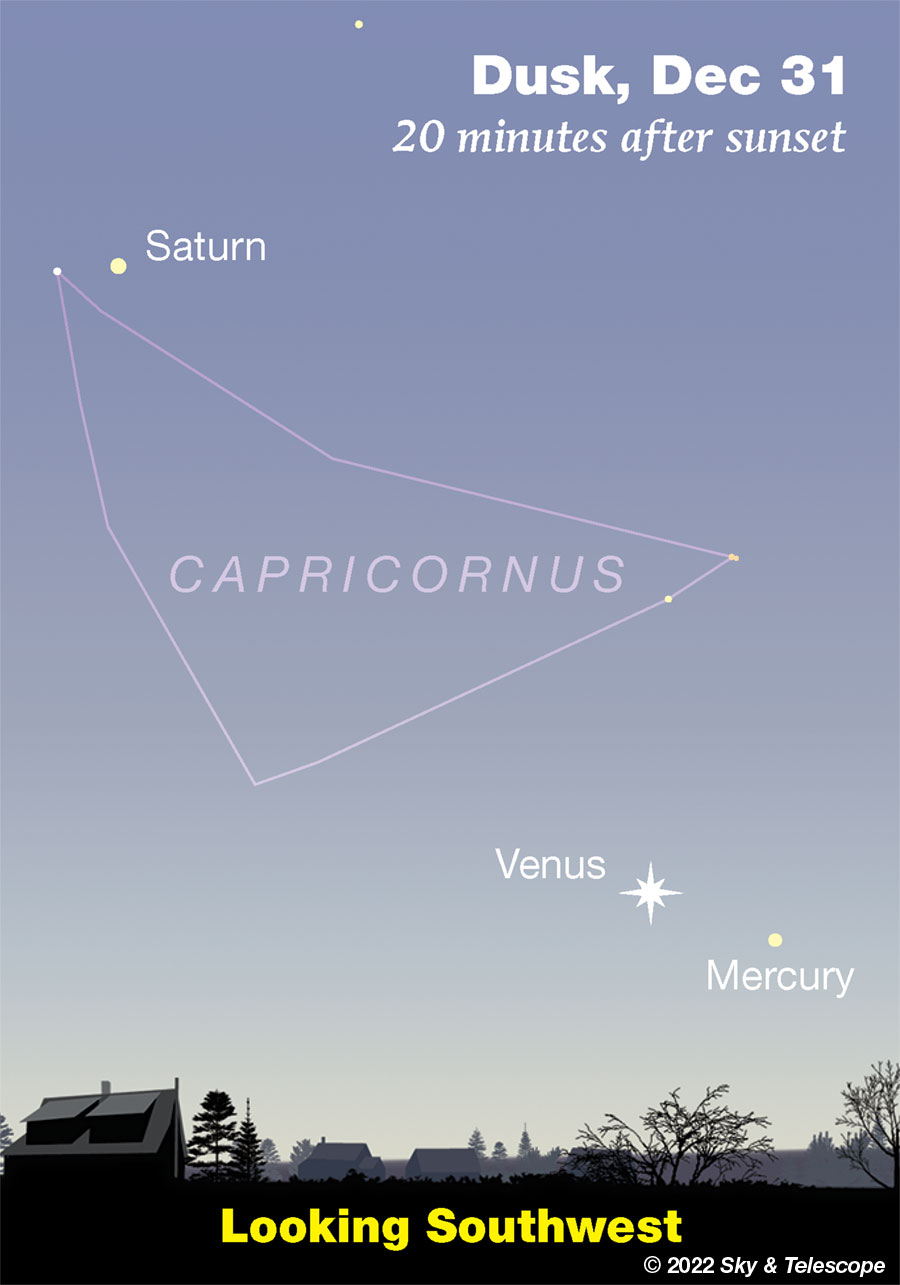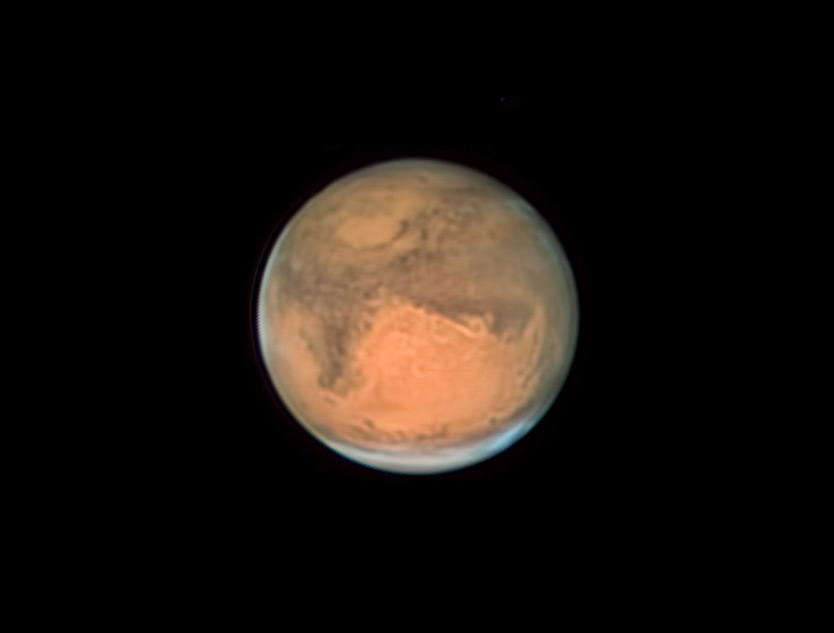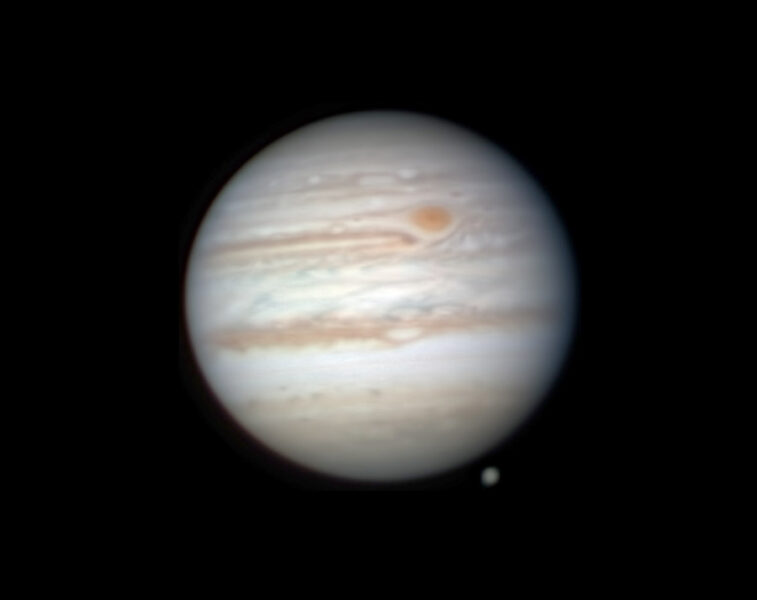FRIDAY, DECEMBER 30
■ Cassiopeia is usually called a flattened letter W, but now it's a flattened M very high overhead around 7 or 8 p.m, just a little west of north.
Three hours later, Cassiopeia has turned around to stand on one end high in the northwest.
■ This evening could be your last chance to catch fast-fading Mercury after sunset. See the illustration below, and bring binoculars.

SATURDAY, DECEMBER 31
■ The Moon in the evening sky is poised almost midway between Jupiter far its right and Mars far to its left.
■ After the noise and cheering at the turning of midnight tonight, step outside into the silent, cold dark. Shining high in the south will be Sirius, with the other bright stars of Canis Major to its right and below it. Sirius is the bottom star of the bright, equilateral Winter Triangle. The others are Betelgeuse in Orion's shoulder to Sirius's upper right, and Procyon the same distance to Sirius's upper left. The Triangle now stands upright, just about in precarious balance on the point of Sirius. Happy New Year.
SUNDAY, JANUARY 1
■ By the start of January Orion has fully come into his own. This week he's striding up the east-southeastern sky as soon as it gets dark, with his three-star Belt nearly vertical. Left of the Belt is orange Betelgeuse; right of the Belt is bright white Rigel. The Belt points up toward Aldebaran and, even higher, the Pleiades. In the other direction, it points down to where bright Sirius rises soon after twilight's end.
■ Algol, high overhead in Perseus, should shine at its minimum brightness, magnitude 3.4 instead of its usual 2.1, for a couple hours tonight centered on 10:42 p.m. EST; 7:42 p.m. PST. Algol takes several additional hours to fade and to rebrighten.
■ For telescope users in western North America, Jupiter's moon Io reappears out of eclipse from Jupiter's shadow at 8:17 p.m. PST; 9:17 MST. In a telescope at 100x or more, watch for Io to gradually appear into view very close to Europa just a little off Jupiter's eastern (following) limb. First one moon will be there, then two. Almost exactly the same thing happened exactly a week ago, for observers in nearly the same parts of the continent.
MONDAY, JANUARY 2
■ Sirius and Procyon in the balance. Sirius, the Dog Star, sparkles low in the east-southeast after dinnertime. Procyon, the Little Dog Star, shines in the east about two fist-widths at arm's length to Sirius's left.
But directly left? That depends. If you live around latitude 30° (Tijuana, New Orleans, Jacksonville), the two canine stars will be at the same height above your horizon soon after they come up. If you're north of that latitude, Procyon will be higher. If you're south of there, Sirius will be the higher one. Depending on your latitude, your eastern horizon tilts differently with respect to the stars.
As the evening goes on, however, Procyon gains the ascendancy no matter where you are (in the Northern Hemisphere).
TUESDAY, JANUARY 3
■ The waxing gibbous Moon shines only about 2° or 3° from Mars this evening, while Aldebaran looks on from their lower right. Although they appear close together, Mars is currently 250 times farther from us than the Moon. Physically, Mars is twice as large as the Moon in diameter.
■ The Quadrantid meteor shower should hit its peak tonight, though moonlight will wash the sky. The peak activity of this short-lived shower, lasting just a few hours, is predicted for around 11 p.m. EST; 7 p.m. PST. The radiant, near the Bootes-Draco border, is circumpolar in the north — but it remains low until the early-morning hours. So the timing of the peak is best for western Europe.
WEDNESDAY, JANUARY 4
■ This evening the Moon shines between the horntips of Taurus: Beta Tauri 2° or 3° to the Moon's upper left, and fainter Zeta Tauri roughly twice as far to the Moon's lower right.
And the Moon is also midway between brighter Capella to its upper left and Betelgeuse to its lower right: about 20° (two fists) from each.
■ Algol should be at its minimum brightness for a couple hours centered on 7:31 p.m. EST.
THURSDAY, JANUARY 5
■ As we enter the deep of winter, the bowl of the Little Dipper hangs straight down from Polaris around 8 p.m., as if from a nail on the cold north wall of the sky.
The brightest star of the Little Dipper's dim bowl is Kochab, at the bowl's lip. It's the equal of Polaris. Kochab itself passes precisely below Polaris about 20 minutes earlier.
FRIDAY, JANUARY 6
■ Full Moon (exact at 6:08 p.m. EST). The Moon rises in the east-northeast just before sunset. After nightfall you can see that it shines between the hearts of the Gemini stick figures, if you use binoculars to help piece out the constellation through the moonlight.
The Moon forms a nice, almost isosceles triangle with brighter Castor and Pollux, Gemini's head stars, to its left. Watch this triangle change shape through the night as the Moon moves eastward along its orbit. The Moon moves against the stars by about its own diameter every hour.
SATURDAY, JANUARY 7
■ Now the bright Moon shines below Castor and Pollux in the evening.
■ After dinnertime, the enormous Andromeda-Pegasus complex runs from near the zenith down toward the western horizon.
Near the zenith, spot Andromeda's high foot: 2nd-magnitude Gamma Andromedae (Almach), slightly orange. Andromeda is standing on her head. Almost halfway down from the zenith to the west horizon is the Great Square of Pegasus, balancing on one corner. Andromeda's head is its top corner.
From the bottom corner run the stars outlining Pegasus's neck and head, ending at his nose: 2nd-magnitude Enif, due west. It too is slightly orange.
This Week's Planet Roundup
Mercury and Venus are very low in the southwest in twilight. Try for them with binoculars 20 or 30 minutes after sunset. Venus is by far the brightest at magnitude –3.9, and it gets a trace higher through the week. But Mercury is dropping and fading fast: from a difficult mag. +0.9 on Friday December 30th (look for it 3° to Venus's right) to an impossible mag. +2.2 just three days later.
Mars continues to fade slowly, from magnitude –1.2 to – 1.0 this week, as it shrinks from 14.8 to 13.7 arcseconds wide. It's a firespark high in the east as the stars come out, still much brighter than orange Aldebaran, mag +0.8, about 8° to its lower right.
Mars gains altitude until culminating nearly overhead, where the telescopic seeing is best, around 9 or 10 p.m.

Jupiter shines high in the south in twilight, then sinks toward the southwest. At magnitude –2.4 it vastly outshines the dim background stars of Pisces. Look for the Great Square of Pegasus above it as the stars come out, and upper right of it later through the evening. It sets around 11 or midnight. Telescopically, Jupiter is down to 39 arcseconds wide.

Saturn, magnitude +0.8 in Capricornus, is getting low in the southwest at nightfall, far to the lower right of Jupiter. It sets around 8 p.m.
Look about two fists at arm's length to Saturn's left for Fomalhaut, and three fists or so to its right for Altair.
Uranus, magnitude 5.7 in Aries, moves high across the south during evening. It displays a tiny, very slightly blue-greenish gray disk 3.7 arcseconds wide. It a telescope at high power it's obviously non-stellar. See the Uranus finder charts in the November Sky & Telescope, page 49.
Neptune, magnitude 7.9 at the Aquarius-Pisces border about 8° west of Jupiter, gets lower through the evening ahead of Jupiter. It's just 2.3 arcseconds wide, again non-stellar in a telescope but requiring more effort than Uranus. It's slightly bluish gray, if you have enough aperture to show color at all in something this faint. See the Neptune finder charts in the September Sky & Telescope, page 49.
All descriptions that relate to your horizon — including the words up, down, right, and left — are written for the world's mid-northern latitudes. Descriptions and graphics that also depend on longitude (mainly Moon positions) are for North America.
Eastern Standard Time (EST) is Universal Time minus 5 hours. Universal Time is also called UT, UTC, GMT or Z time.
Want to become a better astronomer? Learn your way around the constellations. They're the key to locating everything fainter and deeper to hunt with binoculars or a telescope.
This is an outdoor nature hobby. For an easy-to-use constellation guide covering the whole evening sky, use the big monthly map in the center of each issue of Sky & Telescope, the essential magazine of astronomy.
Once you get a telescope, to put it to good use you'll need a detailed, large-scale sky atlas (set of charts). The basic standard is the Pocket Sky Atlas (in either the original or Jumbo Edition), which shows stars to magnitude 7.6.

Next up is the larger and deeper Sky Atlas 2000.0, plotting stars to magnitude 8.5; nearly three times as many. The next up, once you know your way around, are the even larger Interstellarum atlas (stars to magnitude 9.5) or Uranometria 2000.0 (stars to magnitude 9.75). And be sure to read How to Use a Star Chart with a Telescope. It applies just as much to charts on your phone or tablet as to charts on paper.
You'll also want a good deep-sky guidebook. A beloved old classic is the three-volume Burnham's Celestial Handbook. An impressive more modern one is the big Night Sky Observer's Guide set (2+ volumes) by Kepple and Sanner.
Can a computerized telescope replace charts? Not for beginners, I don't think, and not on mounts and tripods that are less than top-quality mechanically, meaning heavy and expensive. And as Terence Dickinson and Alan Dyer say in their Backyard Astronomer's Guide, "A full appreciation of the universe cannot come without developing the skills to find things in the sky and understanding how the sky works. This knowledge comes only by spending time under the stars with star maps in hand."
![]() Audio sky tour. Out under the evening sky with your
Audio sky tour. Out under the evening sky with your
earbuds in place, listen to Kelly Beatty's monthly
podcast tour of the heavens above. It's free.
"The dangers of not thinking clearly are much greater now than ever before. It's not that there's something new in our way of thinking, it's that credulous and confused thinking can be much more lethal in ways it was never before."
— Carl Sagan, 1996
"Facts are stubborn things."
— John Adams, 1770
 2
2









Comments
Rod
December 30, 2022 at 6:45 am
Some good viewing last night. There is much to see, in our solar system, and beyond --Rod
Observed 1815-1930 EST/2315-0030 UT. First Quarter Moon 30-Dec-2022 0121 UT or 2021 EST 29-Dec-2022. I enjoyed some excellent time under the sky tonight. I viewed 25x, 71x, and 129x observations using my 90-mm refractor telescope. TeleVue 40-mm plossl eyepiece, TeleVue 14-mm Delos, and TeleVue 1.8x Barlow lens along with Moon filter, #58 green filter (Jupiter and the Moon), and #23A red filter for Mars. M42 and M45 lovely at 25x and 4 stars in the Trapezium distinct along with the large arc of nebulosity visible. About 1830 EST, a polar orbiting satellite moved south, just passing Jupiter's position. I estimated the apparent magnitude 1.0, it was bright but not as bright as Jupiter. The Sky & Telescope Jupiter and Mars tool worked well. At Jupiter using 71x with green filter, I could see cloud belts, the northern region shaded and some in the south polar area too. 3 Galilean moons on the right side (mirror reverse view) and one on the left side. The Great Red Spot was visible but small at 71x. The GRS transited Jupiter central meridian near 2239 UT according to the December issue of Sky & Telescope, so visible when I looked. The Mars profiler tool showed the central meridian at Mars at 1815 EST or 2315 UT, 321 degrees. Syrtis Major distinct on Mars at 129x using red filter. Mars angular size about 14.9 arcsecond. Jupiter angular size about 39.59 arcseconds. The Virtual Moon Atlas showed the lunar diameter 31.92 arcminute. I did like the green filter view of the First Quarter Moon, that is fun. Very good crater relief and details visible along the terminator line at 71x. You can use Sabine crater, Moltke, and Maskelyne crater to form a triangle and zero in on Apollo 11 landing area. Armstrong crater is there, Aldrin, and Collins. They take high power to see though, usually near 200x for my telescope. When I went out to observe, the Moon and Jupiter a bit more than 6-degrees angular separation in the sky according to Stellarium 1.2. Skies clear, temperature 4C tonight.
You must be logged in to post a comment.
mary beth
December 31, 2022 at 11:06 am
Spectacular way to end the year Rod!
Here in Texas we’ve gone from 16° back up to almost 80° and we’ve had lots of clouds but when it is clear I have thoroughly enjoyed the star (and planet) studded sky. The other night I caught the first quarter moon setting, I think my mom used to call that the Sugarbowl moon when it was in that position.
On another note, Rod, since you are a Muppets fan, I highly recommend a great little show for you and your family tonight. It’s called the “Bells of Fraggle Rock”. It’s probably more of a winter solstice show, but I generally watch it on New Year’s Eve since I always forget to watch it on the 21st. I hope you can find it on YouTube or somewhere because it’s delightful! Very seasonal and cozy!
Happy and Blessed New Year!
You must be logged in to post a comment.
You must be logged in to post a comment.